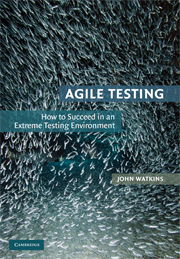Book contents
- Frontmatter
- Contents
- Foreword by Bob Bartlett
- Acknowledgments
- 1 Introduction
- PART 1 REVIEW OF OLD-SCHOOL AND AGILE APPROACHES
- PART 2 EVERYONE IS DIFFERENT: AGILE CASE STUDIES
- PART 3 AGILE MY WAY: A PROPOSAL FOR YOUR OWN AGILE TEST PROCESS
- APPENDIX A The Principles of Rapid Application Development
- APPENDIX B The Rules and Practices of Extreme Programming
- Appendix C The Principles of the Dynamic Systems Development Method
- Appendix D The Practices of Scrum
- APPENDIX E Agile Test Script Template
- Appendix F Agile Test Result Record Form Template
- Appendix G Agile Test Summary Report Template
- Appendix H My Agile Process Checklist
- References
- Index
PART 1 - REVIEW OF OLD-SCHOOL AND AGILE APPROACHES
Published online by Cambridge University Press: 26 October 2009
- Frontmatter
- Contents
- Foreword by Bob Bartlett
- Acknowledgments
- 1 Introduction
- PART 1 REVIEW OF OLD-SCHOOL AND AGILE APPROACHES
- PART 2 EVERYONE IS DIFFERENT: AGILE CASE STUDIES
- PART 3 AGILE MY WAY: A PROPOSAL FOR YOUR OWN AGILE TEST PROCESS
- APPENDIX A The Principles of Rapid Application Development
- APPENDIX B The Rules and Practices of Extreme Programming
- Appendix C The Principles of the Dynamic Systems Development Method
- Appendix D The Practices of Scrum
- APPENDIX E Agile Test Script Template
- Appendix F Agile Test Result Record Form Template
- Appendix G Agile Test Summary Report Template
- Appendix H My Agile Process Checklist
- References
- Index
Summary
Fact of the matter is, there is no hip world, there is no straight world. There's a world, you see, which has people in it who believe in a variety of different things. Everybody believes in something and everybody, by virtue of the fact that they believe in something, use that something to support their own existence.
Frank ZappaThis section of the book provides a review of both the traditional or “classic” view of software testing process and agile approaches.
The chapters in this section are:
Chapter 2 – Old-School Development and Testing, which begins by reviewing the traditional or “classic” view of software testing process. This chapter will explore the good and bad aspects of classic test process, and provides a useful baseline for the rest of the book to build on
Chapter 3 – Agile Development and Testing, which provides a review of the most prominent agile approaches that have been used to develop software, with particular emphasis on the testing aspects of the method described. If additional information on a particular approach is needed, more complete details of each method are provided in Appendices A to D.
- Type
- Chapter
- Information
- Agile TestingHow to Succeed in an Extreme Testing Environment, pp. 5 - 6Publisher: Cambridge University PressPrint publication year: 2009



